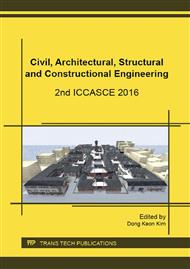[1]
S. J. Dyke, et al., Modeling and control of magnetorheological dampers for seismic response reduction, Smart Mater. Struct. 5(5) (1996) 565-575.
DOI: 10.1088/0964-1726/5/5/006
Google Scholar
[2]
S. Y. Ok, D. S. Kim, K. S. Park, H. M. Koh, Semi-active fuzzy control of cable-stayed bridges using magneto-rheological dampers, Eng. Struct. 29(5) (2007) 776-788.
DOI: 10.1016/j.engstruct.2006.06.020
Google Scholar
[3]
H. J. Jung, K. M. Choi, B. F. Spencer, I. W. Lee, Application of some semi-active control algorithms to a smart base-isolated building employing MR dampers, Struct. Control Health Monit. 13(2-3) (2006) 693-704.
DOI: 10.1002/stc.106
Google Scholar
[4]
D. A. Shook, P. N. Roschke, O. E. Ozbulut, Superelastic semi-active damping of a base-isolated structure, Struct. Control Health Monit. 15(5) (2008) 746-768.
DOI: 10.1002/stc.276
Google Scholar
[5]
D. C. Karnopp, M. J. Crosby, R. A. Harwood, Vibrationcontrol using semi-active force generators, J. Engrg. Ind. 96(2) (1974) 619-626.
DOI: 10.1115/1.3438373
Google Scholar
[6]
Q. Feng, M. Shinozuka, Use of a variable damper for hybrid control of bridge response under earthquake, Proc., U.S. Nat. Workshop on Struct. Control Res., University of Southern California, Los Angelos, (1990) 107-112.
Google Scholar
[7]
E. A. Johnson, B. Erkus, Dissipativity and performance analysis of smart dampers via LMI synthesis, Struct. Control Health Monit. 14(3) (2007) 471-496.
DOI: 10.1002/stc.169
Google Scholar
[8]
M. Askari, J. Li, B. Samali, Semi-active LQG control of seismically excited nonlinear buildings using optimal Takagi-Sugeno inverse model of MR dampers, Proc. Eng. 14 (2011) 2765-2772.
DOI: 10.1016/j.proeng.2011.07.348
Google Scholar
[9]
M. Bitaraf, L. R. Barroso, S. Hurlebaus, Adaptive control to mitigate damage impact on structural response, J. Intell. Mater. Syst. Struct. 21(6) (2010) 607-619.
DOI: 10.1177/1045389x10361993
Google Scholar
[10]
Z. D. Xu, Y. P. Shen, Y. Q. Guo, Semi-active control of structures incorporated with magnetorheological dampers using neural networks, Smart Mater. Struct. 12(1) (2003) 80-87.
DOI: 10.1088/0964-1726/12/1/309
Google Scholar
[11]
M. Bitaraf, et al. Application of semi-active control strategies for seismic protection of buildings with MR dampers, Eng. Struct. 32(10) (2010) 3040-3047.
DOI: 10.1016/j.engstruct.2010.05.023
Google Scholar
[12]
G.W. Housner, et al. Structural control: Past, present, and future, J. Eng. Mech. ASCE, 123(9) (1997) 897-971.
Google Scholar
[13]
S. Cetin, E. Zergeroglu, S. Sivrioglu, I. Yuksek, A new semiactive nonlinear adaptive controller for structures using MR damper: design and experimental validation, Nonlinear Dyn. 66(4) (2000) 731-743.
DOI: 10.1007/s11071-011-9946-0
Google Scholar
[14]
Y. Kim, R. Langari, S. Hurlebaus, Semiactive nonlinear control of a building with a magnetorheological damper system, Mech. Syst. Signal Process. 23(2) (2009) 300-315.
DOI: 10.1016/j.ymssp.2008.06.006
Google Scholar
[15]
X. Zhang, Z. Xu, Testing and modeling of a CLEMR damper and its application in structural vibration reduction, Nonlinear Dyn. 70(2) (2012) 1575-1588.
DOI: 10.1007/s11071-012-0557-1
Google Scholar


